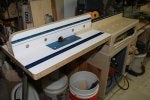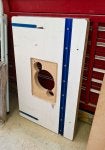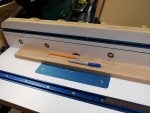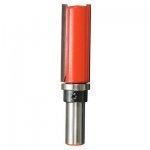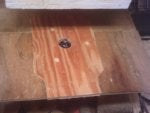Yep like was said, making router tables isn't rocket science. Mine looks pretty rude and crude, especially compared to one like Mike's, but it does what I want and need it for quite nicely. As far as time to make it. I don't know. Likely about two days, counting time for the glue to set. But when I made it I was in one of my Zen woodworking moods (knew what I wanted, didn't know how to do it, grabbed a piece of wood, mind went blank), and still can't say how I made it, let alone how long it took. Cost, not counting some recycled nuts, bolts, washers, was probably -$2 - no stand, it's fixed to a shelf, and I sit to use it. It's been making me happy for somewhere over 10 years, minimum.
Make yourself happy, make your own router table. If it doesn't make you happy, no problem, tear it apart and make another. I think I am on #4 or 5 myself.
I think I have a photo stuck away. Have no clue whatsoever how I came up with the idea for the top, or router plate. I don't even remember cutting them out. Zen woodworking. I have a router plate for each of my routers. Pop one out, drop a different one in, in just seconds. If you look close you can see the top is 3 pieces, not including the router plate. No clue where I came up with that one, but it must have saved a lot of time in cutting out for the router plate, which has a slight edge under it to hold it up. Spider web of 2X4 chunks underneath makes my 1/2" plywood top warp proof, still totally flat. The fit is all very good, just wish I knew what I did to do that. That is an old B&D, 1/4 or 1/3 HP, router in it, at least 10 years old, I know because I have 4 or 5 and they are all the same, all between 10-22 years old. All work fine, except for one that needs a wire re-soldered in place, then ta da.



